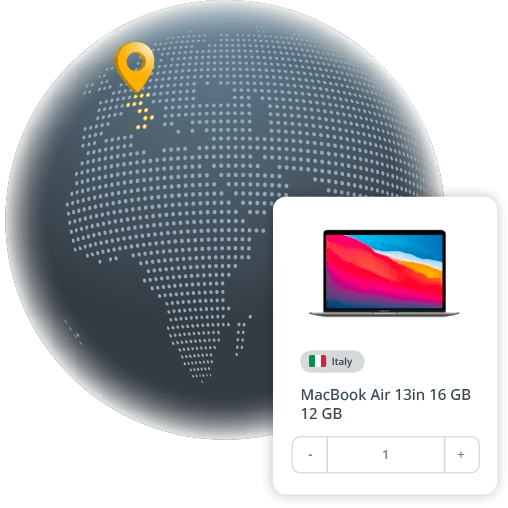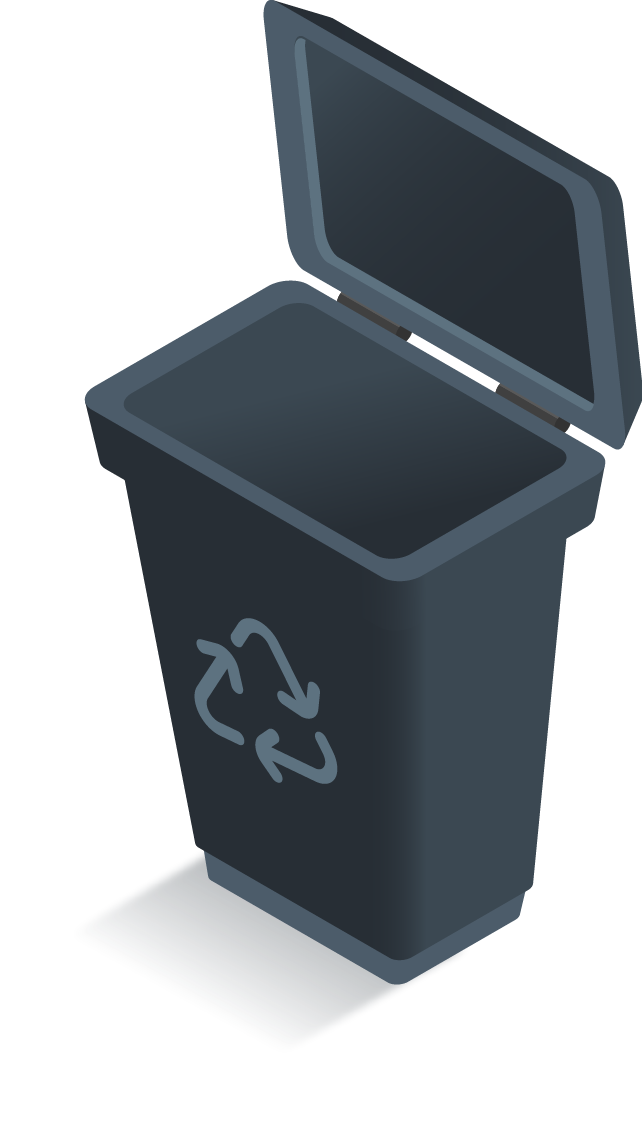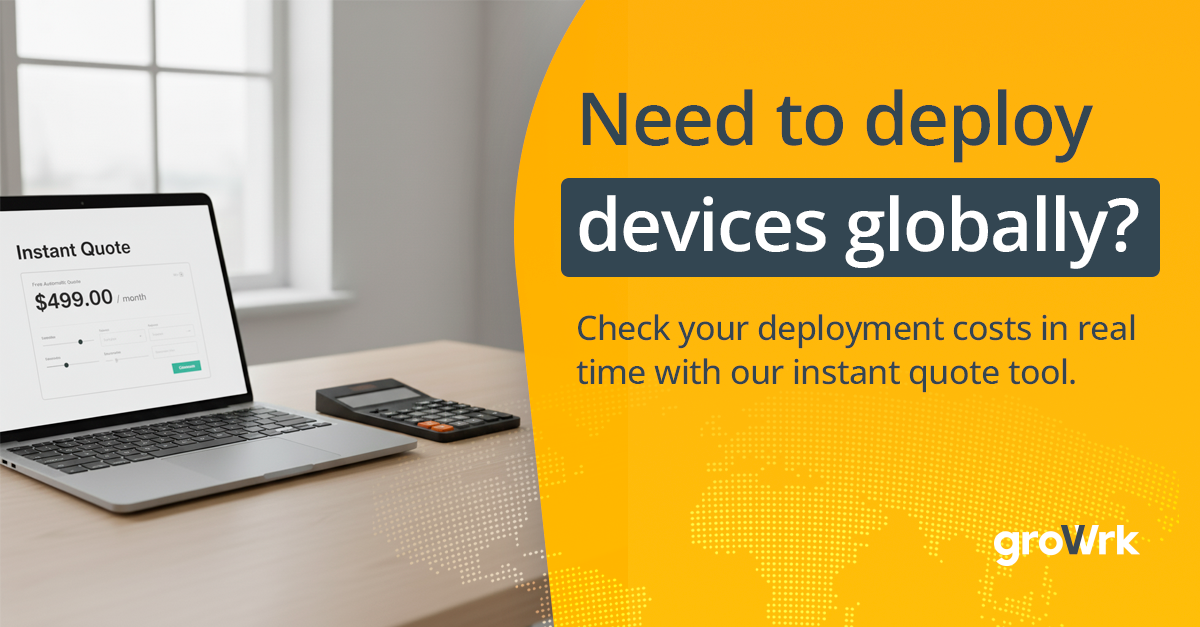How to send IT equipment to Italy
Need to send IT equipment to your remote teams in Italy? Let GroWrk handle the logistics, so you don’t have to! Whether it’s laptops, servers, or any other tech gear, we ensure that the shipping process for your IT assets is seamless and hassle-free.

At a glance
Italy, located in the heart of the Mediterranean, offers a dynamic and thriving business environment, with a rapidly growing tech sector. Known for its high-quality infrastructure and skilled workforce, Italy is becoming a significant player in the global technology and innovation scene. The country’s strategic location, favorable business climate, and strong commitment to digital transformation make it an ideal destination for companies looking to expand in Europe.
|
CURRENCY Euro (€) |
OFFICIAL LANGUAGE Italian (English is widely spoken in business settings) |
TIME ZONE Central European Time (CET) GMT+01:00 Central European Time (CET) during winter; Central European Summer Time (CEST) GMT+2 during daylight saving time |
|
CUSTOMS DUTY ON ELECTRONICS 0-5% + 22% VAT Typically 0-5% customs duties and 22% VAT, with possible exemptions for certain goods within the EU |
SHIPPING LEAD TIME 2-4 days (depending on location and shipping method) |
IT OUTSOURCING MARKET €3.89 billion Italy’s IT outsourcing market is expected to reach €3.89 billion in 2025, driven by a talented workforce, advanced digital infrastructure, and a thriving tech startup ecosystem. |
Overview of IT operations in Italy

Cutting-edge IT infrastructure: Italy boasts an impressive IT infrastructure, including widespread high-speed internet and a growing network of data centers. This makes it a pivotal hub for cloud services, hosting, and companies seeking to scale their operations across Europe.
Commitment to sustainability: Italy places a strong emphasis on sustainability. The government has rolled out initiatives designed to reduce the tech industry's carbon footprint, encouraging businesses to adopt eco-friendly IT solutions. This commitment shapes a future where innovation and environmental responsibility go hand in hand.
Skilled workforce: With a robust focus on tech education, Italy has developed a deep pool of talent in areas such as software development, cybersecurity, and systems administration. This offers businesses a skilled workforce ready to support their growth and innovation.
Business-friendly environment: Italy's favorable business climate is supported by clear regulations, competitive tax incentives, and strong data protection laws. These factors make Italy an increasingly attractive destination for international tech firms and investors seeking collaboration and growth opportunities.
Enhanced cybersecurity: As cyber threats evolve, Italy is strengthening its cybersecurity framework. The country has implemented comprehensive laws and measures to safeguard digital systems, critical infrastructure, and sensitive data, ensuring a secure environment for businesses and consumers.
Thriving tech ecosystem: Italian cities such as Milan and Rome are buzzing with entrepreneurial energy and innovation. The startup ecosystem is flourishing, fueled by venture capital, government incentives, and abundant networking opportunities. Italy is fast becoming one of Europe’s most exciting tech innovation and business development hubs.
Shipping IT equipment to Italy: What you need to know
| Customs regulations |
|
| Duties and taxes |
|
| Required documentation |
|
| Import restrictions |
|
| New vs. Used equipment |
|
| Customs clearance process |
|
| Penalties or fines for non-compliance |
|
Checklist for sending laptops to Italy
When shipping laptops to Italy, following a few best practices is important to ensure the process goes smoothly and your equipment arrives safely and on time. Here are some helpful shipping tips:

Select trusted couriers: Choose reliable couriers such as GroWrk, DHL, UPS, FedEx, or Poste Italiane for international shipping. These carriers provide tracking and have experience with Italian customs and delivery logistics.
Check service levels: Select the appropriate shipping option based on urgency. Express shipping (2-5 days) for high-priority deliveries. Standard shipping (5-10 days) for cost-effective options.
Use high-quality packaging: Secure laptops with sturdy, padded boxes and protective materials like bubble wrap, foam inserts, or air cushions to prevent damage during transit.
Disassemble where possible: If shipping accessories like chargers, docking stations, or monitors, package them separately to prevent damage. Remove detachable components if applicable.
Label clearly: Ensure the recipient’s name, address, and contact details are correctly labeled. Mark the package as "fragile" to encourage careful handling.
Accurate product descriptions: On the commercial invoice, provide a detailed and accurate description of the laptop, including its brand, model, and serial number. Inaccurate descriptions may cause customs delays.
Value declaration: Declare the correct value of the laptop to avoid under- or over-declaring, which could lead to customs inspections or fines. The declared value determines any applicable duties and taxes.
Customs declarations: Since Italy is in the EU, shipments from within the EU do not require customs clearance. However, for shipments from outside the EU, include: EU Single Administrative Document (SAD), commercial invoice, and packing list
Proof of origin: If applicable, include a certificate of origin to determine eligibility for preferential trade agreements, which may reduce duties.
Understand import duties & taxes: Laptops are duty-free under EU rules but are subject to 22% VAT on the CIF value (Cost + Insurance + Freight).
Pre-pay duties and taxes: Some couriers allow for pre-paid duties and taxes to simplify customs clearance and prevent the recipient from facing unexpected charges upon arrival.
Protect against loss or damage: Consider purchasing shipping insurance for high-value laptops to protect against loss, theft, or damage during transit.
Compliance with Italian regulations: Ensure compliance with EU electronic safety standards, including CE marking, WEEE (Waste Electrical and Electronic Equipment), and RoHS (Restriction of Hazardous Substances) regulations before shipping.
Use tracking tools: Major couriers provide real-time tracking—monitor shipments closely to anticipate customs clearance updates and delivery progress.
Stay in touch with the recipient: Notify the recipient about the expected delivery timeline, tracking updates, and any customs-related requirements to avoid delays.
Expect weather and seasonal delays: Plan for possible delays during national holidays, Black Friday, Christmas, or periods of extreme weather like heatwaves or snow.
Italian domestic delivery options: For final delivery, consider Poste Italiane, SDA, BRT, GLS Italy, or Nexive for efficient last-mile distribution across Italy.

Average cost of IT Equipment in Italy
Laptops (Business Grade):
- Mid-range: €1,100 - €2,400
- High-end: €2,400 - €4,800
High-end models such as Apple MacBook Pro, Dell XPS, and Lenovo ThinkPad are priced on the higher end.
Monitors (Business Grade):
- Standard: €300 - €600
- Ultrawide/4K: €850 - €1,700
Monitors from trusted brands like Dell, Samsung, and LG typically range within these prices, with 4K or ultrawide models costing more.
Desktops (Business Grade):
- Standard Desktop PC: €1,000 - €3,500
- Workstation Desktop (for high-performance tasks): €3,500 - €8,000+
Prices depend on the brand and specifications, with options from HP, Lenovo, and Apple among the most common.
Printers (Laser):
- Standard Office Printers: €300 - €1,000
- High-Volume Printers: €1,300 - €3,500
Leading brands such as HP, Canon, and Brother offer a wide range of models for office environments.
Public holidays & IT work hours to plan your shipment
-
Key public holidays in Italy:
- New Year's Day – January 1
- Epiphany – January 6
- Easter Sunday – Date varies (typically April)
- Easter Monday – The Monday following Easter
- Labour Day – May 1
- Republic Day – June 2
- Ferragosto (Assumption of the Virgin Mary) – August 15
- All Saints' Day – November 1
- Immaculate Conception – December 8
- Christmas Day – December 25
- St. Stephen's Day (Boxing Day) – December 26
Typical work hours for IT professionals
- Standard workweek
- The usual workweek in Italy consists of 40 hours, generally from 9:00 AM to 6:00 PM, Monday to Friday. That said, many IT companies now offer more flexibility, allowing employees to adjust their hours to fit personal commitments or preferences, as long as they fulfill the required number of weekly hours.
- Remote work has also become a significant part of the modern work culture in Italy, with numerous businesses offering their employees the option to work from home or other locations, depending on the job and company policies.
- Overtime
- Employment contracts regulate overtime in Italy and can vary by company. When overtime is required, employees are generally entitled to compensation, which can be additional pay or time off.
- Overtime pay typically amounts to 1.25 times the standard hourly rate for work beyond the usual hours. However, depending on the employer's policies, this rate may increase for weekend or public holiday work.
- Public holiday work
- Italy observes several public holidays throughout the year, such as New Year’s Day, Easter Monday, Labour Day, Republic Day, Ferragosto, and Christmas Day. Most IT professionals enjoy these holidays off, with many businesses closing or operating with reduced hours.
- Employees required to work on public holidays are usually entitled to premium pay, typically higher than their regular hourly wage. In some cases, employees may also be given extra time off in the future as compensation for working during these holidays. This approach ensures fair compensation and protects employees' rights when working outside the standard workweek.
What to consider when retrieving IT equipment from employees in Italy
| Local delivery and logistics services |
|
| Inventory management |
|
| Logistics challenges for remote locations |
Shipping IT equipment to remote areas of Italy can present various logistical obstacles, mainly due to inconsistent infrastructure and limited access to transportation networks. Below are some critical factors to consider when shipping to these less accessible locations:
|
| Equipment agreement with employees |
|
How to dispose of IT equipment in Italy
Data wiping
- Data wiping: To ensure sensitive data is securely erased, use certified software to completely wipe data from hard drives, SSDs, and other storage devices. This step is crucial to protect confidential information from being recovered by unauthorized individuals.
- Shredding and destruction: Physical destruction of storage devices is the most secure option for higher-security needs. This can include methods like shredding or other forms of destruction that make it impossible to recover any data.
WEEE compliance (Waste Electrical and Electronic Equipment Directive)
- Certified e-waste disposal: To comply with Italy's environmental regulations, it’s important to use certified e-waste disposal services that comply with the EU's WEEE Directive. These services handle the safe dismantling of equipment and ensure hazardous materials such as batteries and mercury are disposed of correctly.
- Recycling centers: Smaller electronics can usually be dropped off at designated recycling centers, while larger items like servers or bulk office equipment may require specialized disposal services.
Repurposing IT equipment
- Donation to charitable organizations: If your IT equipment is still in good working condition, consider donating it to schools, charities, or non-profit organizations. Many organizations in Italy would benefit from functional tech equipment donations, allowing you to give your old devices a second life while supporting a good cause.
- Internal repurposing: Companies that frequently upgrade their IT systems can reuse older devices for non-critical tasks or distribute them to departments with lower technology needs.
Manufacturer take-back programs
Many manufacturers in Italy offer take-back programs, where businesses can return their old equipment for recycling or reuse. This is a simple way to ensure responsible disposal while complying with local environmental laws.
Certified e-waste recycling providers
When selecting an e-waste provider, ensure they’re certified by Italy's environmental authorities, such as the Ministero dell'Ambiente or other recognized agencies. Certified providers will dispose of your equipment correctly and provide you with certificates of destruction or recycling, confirming that you’ve met legal requirements.

Local IT Outsourcing Solutions in Italy
You can streamline your IT logistics and asset management with GroWrk’s comprehensive global solution. Whether it’s shipping equipment or managing IT assets across multiple regions, GroWrk helps you stay compliant and efficient, every step of the way. Here’s why GroWrk is the ideal partner for managing your IT assets in Italy:

| 1. Wide global coverage |
At GroWrk, we offer seamless IT outsourcing services in over 150 countries, including Italy. With our deep understanding of the local market, we provide solutions that are perfectly aligned with Italian regulations and industry standards, so your teams can operate with confidence and compliance. |
| 2. End-to-end asset management |
We manage your IT assets from start to finish—whether it’s procurement, maintenance, or disposal, we handle it all. By entrusting us with your IT infrastructure, your team can stay focused on their core tasks, knowing that your IT resources in Italy are in good hands and well-maintained. |
| 3. Intuitive platform for easy deployment |
Our user-friendly platform makes deploying, tracking, and shipping IT assets in Italy a breeze. With all processes centralized in one system, we eliminate any logistical headaches, ensuring your operations run smoothly and efficiently, without any unnecessary delays. |
| 4. Smooth delivery and equipment retrieval |
GroWrk guarantees fast and secure delivery of laptops and other IT devices to your team members across Italy. We also handle the retrieval of equipment when employees leave the company, so you don’t have to worry about logistics—just focus on growing your business with peace of mind. |
| 5. Compliance with Italian import regulations |
We take the stress out of compliance by ensuring that all your IT shipments comply with Italy’s import regulations, including VAT, customs duties, and any applicable taxes. With GroWrk, you can be sure your equipment will arrive on time and without any costly delays or compliance issues. |
| 6. Efficient repairs and maintenance |
We provide top-notch repair and maintenance services to keep your devices running smoothly. Our quick and efficient support minimizes downtime, ensuring your teams in Italy stay productive and focused without any long interruptions. |
| 7. 24/7 Support for peace of mind |
Our dedicated customer support team is available around the clock to assist with any questions or concerns related to asset management, logistics, or shipping. No matter the time, GroWrk is always here to help, ensuring your IT operations in Italy run seamlessly at all hours. |
Procure, configure, and deploy your IT devices from one platform


